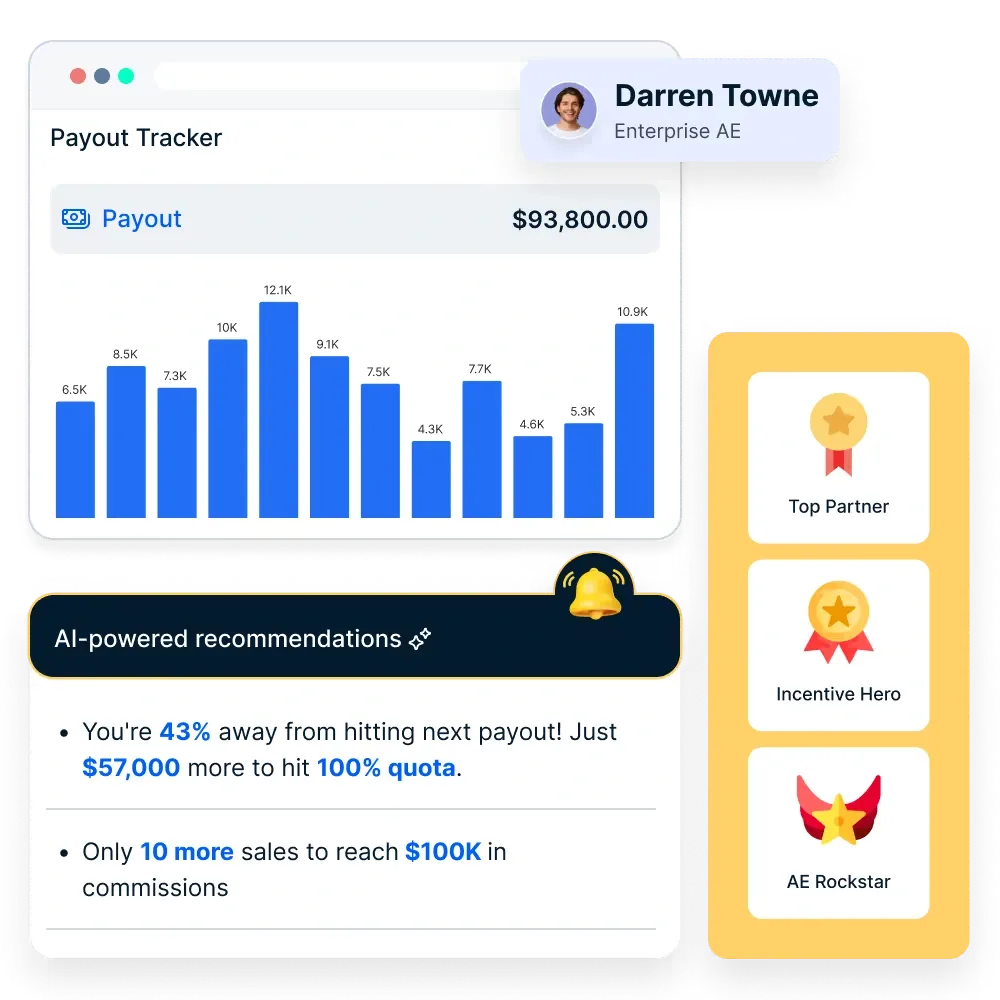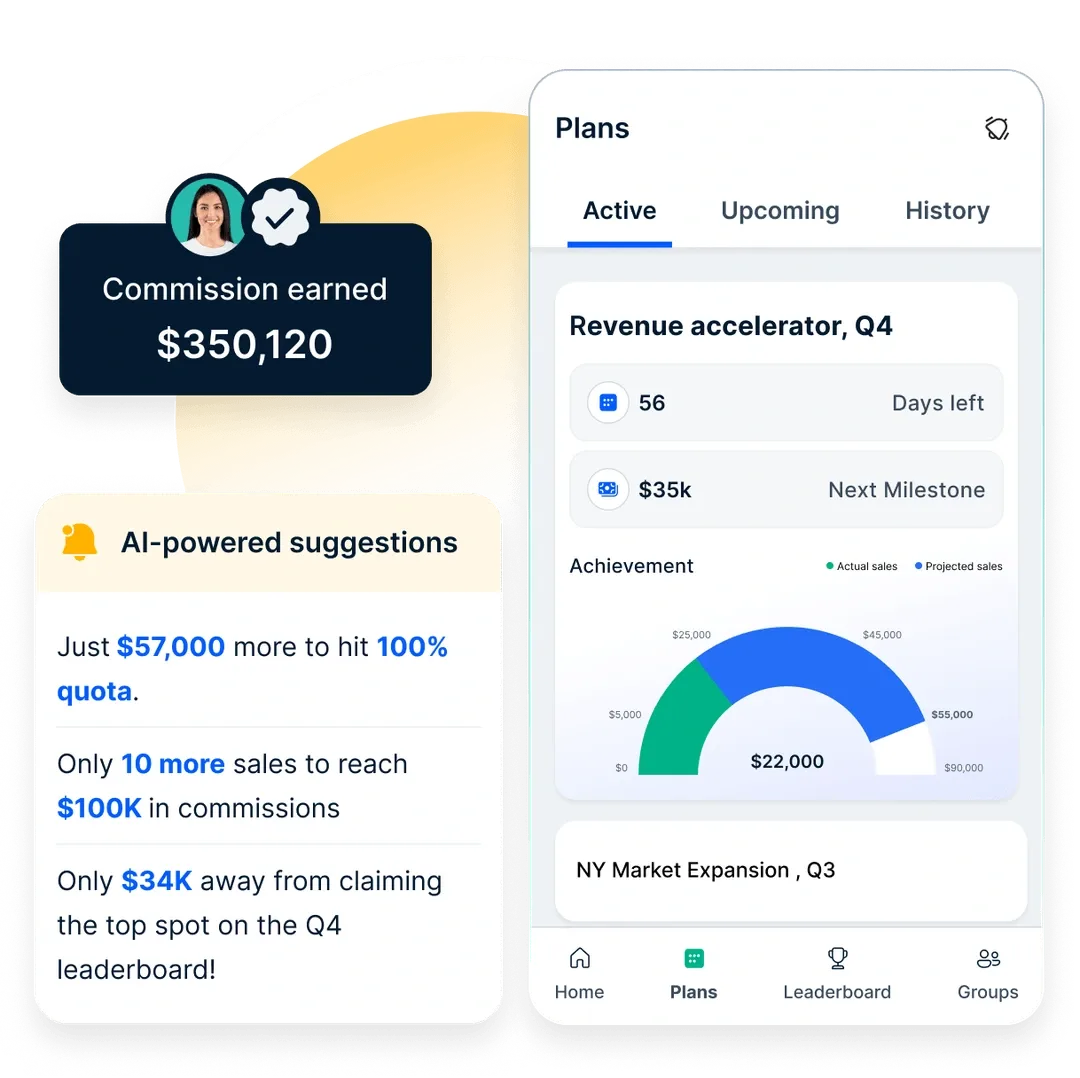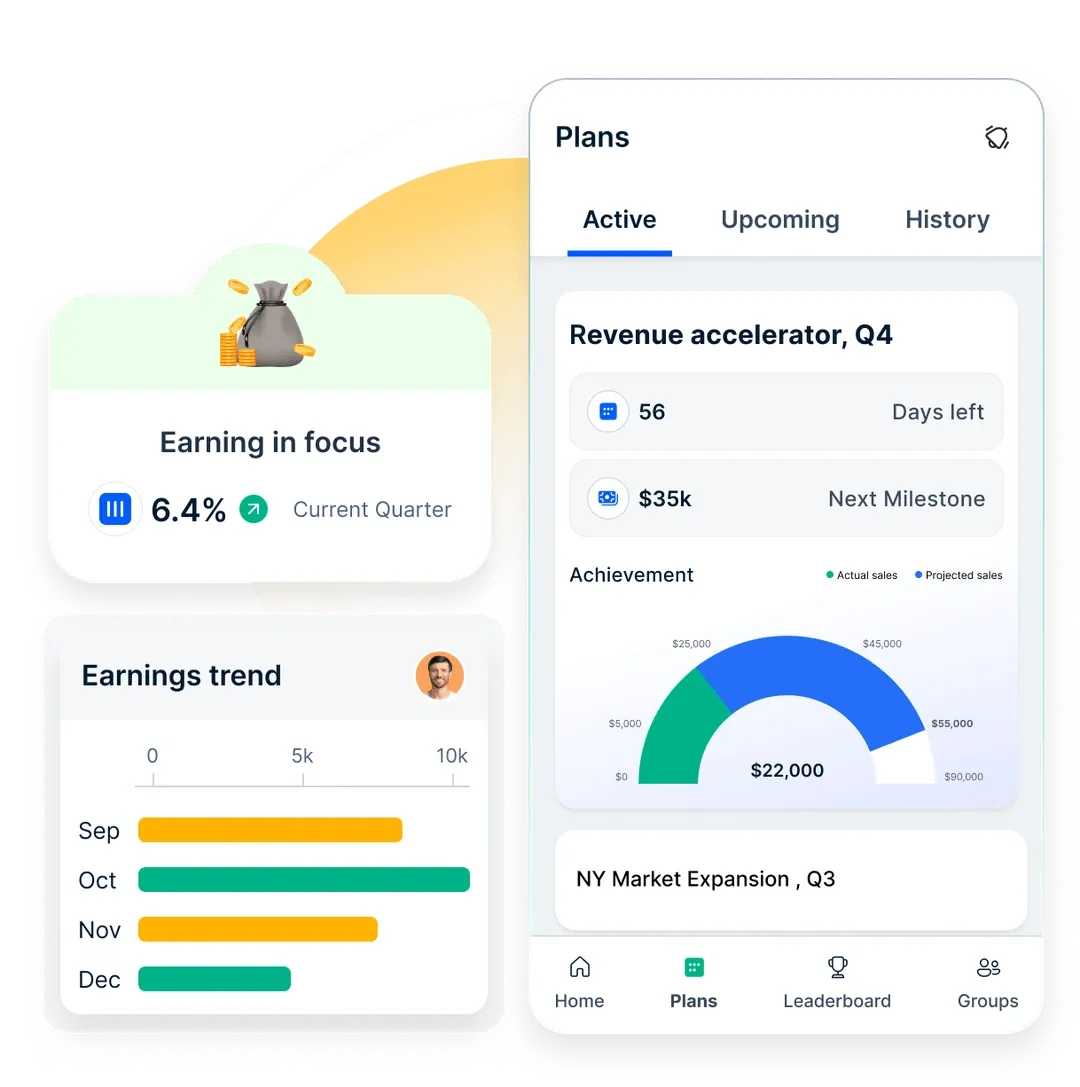Cómo mejorar el rendimiento de las ventas: 15 métodos probados para obtener mejores resultados
Aprenda a mejorar el rendimiento de las ventas mediante técnicas de venta y procesos de racionalización. Esta guía incluye estrategias prácticas para aumentar la eficiencia, cerrar más tratos e impulsar el crecimiento.
En esta página
Cómo mejorar el rendimiento de las ventas es una pregunta que todos los profesionales de ventas se plantean en algún momento. Aunque vender es una responsabilidad fundamental, el tiempo dedicado a la prospección, la generación de oportunidades y el seguimiento puede ser decisivo para el éxito. A informe de Gartner destaca que los representantes de ventas sólo disponen del 5% del tiempo de un cliente a lo largo de todo el proceso de compra B2B, por lo que es crucial maximizar cada interacción.
Para mejorar el rendimiento de las ventas, las empresas deben centrarse en optimizar los procesos de ventas, mejorar la interacción con los clientes y aprovechar los datos. Ya se trate de perfeccionar los argumentos de venta, utilizar herramientas de automatización o agilizar el seguimiento, los pequeños cambios pueden conducir a grandes victorias.
En esta guía exploraremos formas de mejorar el rendimiento de las ventas con técnicas prácticas que aumentan la eficacia, cierran más tratos e impulsan el crecimiento a largo plazo.
Tanto si es un profesional de las ventas como si es propietario de una empresa, estas estrategias le ayudarán a maximizar sus esfuerzos y a obtener mejores resultados.
Empecemos.
15 formas de mejorar el rendimiento de las ventas
Para alcanzar los objetivos de crecimiento e ingresos, mejorar el rendimiento de las ventas es crucial para cualquier empresa.
He aquí 15 formas eficaces de mejorar el rendimiento de las ventas:
1. Establecer objetivos claros y alcanzables
Establecer objetivos de ventas claros y alcanzables es la base para mejorar el rendimiento de las ventas. Los objetivos proporcionan dirección, motivación y un sentido de propósito a los equipos de ventas.
A la hora de fijar objetivos, es esencial que sean específicos, medibles, alcanzables, relevantes y con un plazo determinado (SMART). Por ejemplo, un objetivo SMART podría ser aumentar las ventas mensuales un 20% en el próximo trimestre. Al tener estos objetivos específicos en mente, los equipos de ventas pueden alinear sus esfuerzos y estrategias para alcanzarlos.
Además, los objetivos deben dividirse en hitos más pequeños, lo que los hace más manejables y ayuda a los vendedores a realizar un seguimiento regular de sus progresos. La medición periódica del rendimiento con respecto a estos hitos permite corregir el rumbo si es necesario.
2. Invertir en formación y desarrollo de ventas
Unos profesionales de ventas bien formados y capacitados pueden influir significativamente en el rendimiento de las ventas. Invertir en programas de formación y desarrollo es esencial para mantener al equipo de ventas al día de las tendencias del sector, el conocimiento de los productos y las técnicas de venta. La formación debe centrarse en mejorar las habilidades de comunicación, las tácticas de negociación, la gestión de objeciones y la comprensión de las necesidades del cliente.
Los talleres periódicos, los ejercicios de simulación y la formación continua pueden reforzar el aprendizaje y ayudar a los vendedores a aplicar sus conocimientos con eficacia. Al mejorar continuamente sus habilidades, los equipos de ventas pueden adaptarse a la dinámica cambiante del mercado y a las demandas de los clientes, lo que se traduce en un mejor rendimiento de las ventas.
3. Implantar un sistema de gestión de las relaciones con los clientes (CRM)
Un sistema CRM es una potente herramienta que permite a los equipos de ventas gestionar los datos de los clientes, realizar un seguimiento de los clientes potenciales y supervisar las interacciones de ventas de forma eficaz. Ayuda a agilizar los flujos de trabajo y los procesos de ventas, haciéndolos más organizados y eficientes. Un buen sistema CRM proporciona información valiosa sobre el comportamiento, las preferencias y las interacciones anteriores de los clientes, lo que permite a los representantes de ventas personalizar su enfoque y adaptar las soluciones a cada cliente.
Con un CRM, los representantes de ventas pueden dar prioridad a los clientes potenciales, hacer un seguimiento de las oportunidades y cultivar las relaciones de forma más eficaz. Esto, a su vez, mejora la satisfacción del cliente y aumenta las posibilidades de cerrar acuerdos.
4. Incentivar y reconocer el rendimiento
Ofrecer los incentivos y el reconocimiento adecuados por los logros de ventas puede ser un poderoso motivador. Los incentivos pueden incluir comisiones, primas u otras recompensas vinculadas al cumplimiento o la superación de los objetivos de ventas. Reconocer públicamente a los que más rinden dentro de la organización levanta la moral y fomenta una competencia sana entre el equipo de ventas.
Es esencial diseñar la estructura de incentivos de forma que se ajuste tanto a los objetivos individuales como a los del equipo. Así se fomenta el trabajo en equipo y la colaboración, al tiempo que se reconocen las contribuciones individuales destacadas.
5. Implantar la gamificación de ventas
La gamificación de las ventas consiste en introducir elementos de juego en el proceso de ventas para motivar e implicar al equipo de ventas. Crea un entorno competitivo y divertido que anima a los representantes de ventas a luchar por la excelencia. La gamificación puede incluir tablas de clasificación, insignias, puntos y recompensas por alcanzar hitos u objetivos específicos.
Al introducir una competencia sana, es más probable que los representantes de ventas se esfuercen por mejorar su rendimiento. Además, la gamificación fomenta la camaradería entre los miembros del equipo, lo que mejora la colaboración y el intercambio de conocimientos.

Transforme las ventas con atractivos concursos
Eleve el rendimiento de su equipo de ventas introduciendo concursos y retos dinámicos. Compass le permite crear concursos personalizados que se alinean con sus objetivos empresariales, fomentando una cultura de logros y colaboración.
Inicie su primer concurso
6. Analizar y aprender de los datos de ventas
La toma de decisiones basada en datos es vital para mejorar el rendimiento de las ventas. Analice los datos de ventas para identificar tendencias, oportunidades y áreas de mejora. Utilice indicadores clave de rendimiento (KPI) como las tasas de conversión, la duración del ciclo de ventas, los costes de adquisición de clientes y el valor del ciclo de vida del cliente para evaluar no sólo su rendimiento de ventas, sino también el impacto de su estrategia de estrategia SDR.
El análisis de datos le permite detectar cuellos de botella, identificar estrategias de éxito y comprender mejor las preferencias de los clientes. Este conocimiento le permite perfeccionar continuamente su enfoque de ventas, optimizando esfuerzos y recursos.
7. Centrarse en la retención de clientes y en las ventas
Aunque la captación de nuevos clientes es esencial, también lo es centrarse en la fidelización y la venta de productos de calidad a los clientes existentes. Los clientes fieles suelen ser más rentables a largo plazo y pueden convertirse en defensores de la marca, lo que se traduce en recomendaciones boca a boca.
Para mejorar la retención de clientes, dé prioridad a un excelente servicio de atención al cliente, atienda con prontitud cualquier problema o preocupación y mantenga una comunicación regular con los clientes. Para hacer upselling, identifique productos o servicios adicionales que complementen lo que el cliente ya utiliza y ofrézcale recomendaciones a medida en función de sus necesidades.
8. Fomentar la retroalimentación y la comunicación continuas
La comunicación abierta y transparente dentro del equipo de ventas es vital para mejorar. Anime a los representantes de ventas a comentar regularmente sus experiencias, retos y sugerencias de mejora. Del mismo modo, proporcione comentarios constructivos y formación para ayudar a los representantes de ventas a perfeccionar sus habilidades.
Las reuniones periódicas de equipo y las sesiones individuales con los jefes de equipo pueden ayudar a abordar las preocupaciones, celebrar los éxitos y crear un entorno de apoyo que fomente el crecimiento y el aprendizaje.
9. Utilizar la prueba social y los testimonios
La prueba social es un fenómeno psicológico por el que las personas tienden a seguir las acciones de los demás cuando no están seguras de qué hacer. Incorpore la prueba social a su estrategia de ventas mostrando reseñas positivas, testimonios y estudios de casos de clientes satisfechos.
Al compartir historias de éxito, se genera confianza y credibilidad entre los clientes potenciales, por lo que es más probable que elijan sus productos o servicios frente a los de la competencia. Los testimonios y los estudios de casos proporcionan ejemplos reales de cómo sus ofertas han ayudado a otras personas, reduciendo así el riesgo percibido de realizar una compra.
10. Adoptar la tecnología y la automatización
Aproveche las herramientas y la tecnología de automatización de ventas para agilizar los procesos, ahorrar tiempo y mejorar la eficacia general. La automatización puede ayudar en la generación de clientes potenciales, la fidelización de clientes potenciales, el marketing por correo electrónico e incluso la gestión de las relaciones con los clientes.
Al automatizar las tareas repetitivas, los representantes de ventas pueden centrarse más en establecer relaciones y cerrar acuerdos. Además, los análisis avanzados y la información basada en datos de la tecnología pueden ayudar a identificar clientes potenciales valiosos y a comprender el comportamiento de los clientes, lo que puede perfeccionar aún más las estrategias de ventas.
La incorporación de estas estrategias adicionales junto con las mencionadas anteriormente puede conducir a un plan de mejora de las ventas completo y sólido, que en última instancia impulse mejores resultados y un crecimiento empresarial sostenible.
11. Personalización y segmentación de clientes
Adaptar su enfoque de ventas a cada cliente puede mejorar significativamente el rendimiento de las ventas. Utilice los datos e información de los clientes para segmentar su audiencia en función de sus características demográficas, preferencias, compras anteriores y comportamiento. Con esta información, puede crear mensajes de marketing personalizados y argumentos de venta que resuenen con cada segmento de clientes.
La personalización hace que los clientes se sientan valorados y comprendidos, lo que aumenta la probabilidad de convertir clientes potenciales en clientes fieles. Además, conocer los puntos débiles específicos de los clientes permite a los representantes de ventas abordar sus necesidades con mayor eficacia, lo que se traduce en mayores tasas de conversión.
12. Ofrecer promociones e incentivos por tiempo limitado
Cree una sensación de urgencia y anime a actuar con rapidez ofreciendo promociones, descuentos o incentivos exclusivos de duración limitada. Las ofertas por tiempo limitado aprovechan el miedo de los clientes a perderse algo (fomo), incitándoles a tomar rápidamente una decisión de compra.
Sin embargo, asegúrese de que las promociones se ajustan a sus objetivos empresariales y no comprometen el valor de sus productos o servicios. Si se utilizan estratégicamente, estas ofertas pueden estimular la demanda y mejorar el rendimiento de las ventas.
Simplifique los complejos planes de compensación con la gestión automatizada de incentivos de Compass. Garantice la precisión y la transparencia en los pagos, alineando las recompensas con el rendimiento para aumentar la moral y la productividad.
Automatice sus incentivos hoy mismo
13. Establecer la alineación entre ventas y marketing
Los equipos de ventas y marketing deben trabajar en sincronía para optimizar el rendimiento de las ventas. La alineación entre estos departamentos garantiza un traspaso fluido de clientes potenciales, mensajes coherentes y una comprensión compartida del público objetivo.
Las reuniones periódicas y la colaboración entre los equipos de ventas y marketing facilitan el intercambio de ideas, comentarios y estrategias. Cuando ambos equipos están alineados, los esfuerzos de marketing generan clientes potenciales de mayor calidad y los equipos de ventas pueden convertirlos con mayor eficacia, lo que se traduce en una mejora del rendimiento general de las ventas.
14. Mejorar la gestión del tiempo y del territorio
Los representantes de ventas suelen disponer de un tiempo limitado para relacionarse con clientes potenciales. Una gestión eficaz del tiempo y el territorio ayuda a maximizar la productividad y a priorizar las oportunidades más prometedoras.
Implemente herramientas y técnicas para optimizar las rutas de viaje, minimizar las tareas administrativas y asignar estratégicamente los territorios de ventas. Además, anime a los representantes de ventas a utilizar su tiempo de forma eficiente centrándose en los clientes potenciales prioritarios y evitando actividades improductivas que no contribuyan a los objetivos de ventas.
15. Supervisar la actividad de la competencia
Vigile de cerca las estrategias, precios y ofertas de sus competidores. Comprender sus puntos fuertes y débiles le permitirá posicionar sus productos o servicios de forma más eficaz y destacar sus puntos de venta exclusivos.
Un análisis periódico de la competencia puede revelar lagunas en el mercado que usted puede aprovechar, así como amenazas potenciales a su cuota de mercado. Al mantenerse informado sobre sus competidores, puede ajustar su enfoque de ventas y mantenerse a la cabeza del panorama competitivo.
La aplicación de estas estrategias junto con las anteriores puede crear un enfoque global y dinámico para mejorar el rendimiento de las ventas. Recuerde que la mejora de las ventas es un proceso continuo, por lo que evaluar periódicamente la eficacia de estas estrategias y realizar los ajustes necesarios es esencial para un éxito sostenido.
Motivar, controlar y ganar: el rendimiento de las ventas, más fácil con Compass
Compass transforma la forma de trabajar de los equipos de ventas combinando información basada en IA, gamificación y automatización. Gracias al seguimiento del rendimiento en tiempo real, los atractivos retos de ventas y la gestión automatizada de comisiones, su equipo se mantendrá motivado, centrado y preparado para conseguir más.
Haga que las ventas sean emocionantes con la gamificación

Los objetivos de ventas tradicionales pueden parecer rutinarios, pero Compass cambia las reglas del juego. Introduzca tablas de clasificación en tiempo real, concursos de ventas y estímulos personalizados para mantener el compromiso de su equipo. Reconozca a los mejores, fomente la competición amistosa y cree una cultura en la que se celebre el éxito.
Automatice las comisiones para mayor precisión y confianza

Las complicadas estructuras de comisiones y los cálculos manuales pueden provocar retrasos y disputas. Compass agiliza todo el proceso con gestión automatizada de comisionesgarantizando que todos los pagos sean precisos, puntuales y transparentes. Cuando su equipo de ventas sabe que sus esfuerzos se recompensan de forma justa, se mantiene motivado para cerrar más acuerdos.
Obtenga información de ventas basada en IA

Comprender el rendimiento de las ventas requiere algo más que instinto. Compass ofrece análisis en tiempo real, seguimiento de métricas clave como las tasas de conversión, el crecimiento de los ingresos y la eficiencia del ciclo de ventas. Utilice información basada en IA para predecir tendencias, identificar áreas de mejora y tomar decisiones estratégicas que impulsen los ingresos.
Eleve su estrategia de ventas con Compass¡Empiece ya!
Conclusión
Mejorar el rendimiento de las ventas es un proceso dinámico y continuo que requiere dedicación, estrategia y adaptabilidad. Si te centras en comprender las necesidades de tus clientes, perfeccionar tus técnicas de venta y aprovechar la tecnología, podrás lograr avances significativos en tu trayectoria de ventas.
Recuerde hacer un seguimiento continuo de sus progresos, celebrar sus éxitos y aprender de los contratiempos. Con determinación y una mentalidad de crecimiento, estarás en el buen camino para lograr unos resultados de ventas excepcionales.
Ahora, ¡sal ahí fuera y aplasta esos objetivos!
¡Feliz venta!
Preguntas frecuentes sobre el rendimiento de las ventas
He aquí algunas preguntas frecuentes sobre el rendimiento de las ventas.
1. ¿Qué significa mejorar el rendimiento de las ventas?
La mejora del rendimiento de las ventas se refiere al aumento de la capacidad de un equipo de ventas o de un vendedor individual para vender más productos o servicios, aumentar la rentabilidad y cumplir o superar los objetivos de ventas. Esto puede lograrse mediante diversos métodos, como la formación y el desarrollo, la mejora de los procesos y el uso eficaz de la tecnología.
2. ¿Cuáles son los factores clave que afectan al rendimiento de las ventas?
Entre los factores clave que afectan al rendimiento de las ventas se encuentran la calidad del producto o servicio, la eficacia del proceso de venta, el nivel de cualificación del equipo de ventas, la eficacia de la estrategia de ventas, las condiciones del mercado y el comportamiento de los clientes.
3. ¿Cómo puedo mejorar el rendimiento de mi equipo de ventas?
La mejora del rendimiento de su equipo de ventas puede lograrse por varios medios, entre ellos impartiendo formación periódica, optimizando el proceso de ventas, estableciendo objetivos claros y realistas, proporcionando herramientas y tecnología de ventas eficaces, creando una estructura de incentivos motivadora y revisando y retroalimentando periódicamente el rendimiento.
4. ¿Qué papel desempeña la formación en el rendimiento de las ventas?
La formación desempeña un papel crucial en el rendimiento de las ventas, ya que dota a los vendedores de las habilidades, conocimientos y estrategias necesarios para vender eficazmente sus productos o servicios. Esto puede incluir el conocimiento del producto, técnicas de venta, habilidades de comunicación, habilidades de negociación y comprensión del mercado objetivo.
5. ¿Cómo puede la tecnología mejorar el rendimiento de las ventas?
La tecnología puede mejorar el rendimiento de las ventas agilizando y automatizando los procesos, proporcionando datos y análisis en tiempo real, mejorando la comunicación y la colaboración dentro del equipo y permitiendo una gestión más eficaz de las relaciones con los clientes. Herramientas como el software CRM, las herramientas de análisis y las plataformas de comunicación pueden ser especialmente útiles.
6. ¿Qué importancia tiene la opinión de los clientes para mejorar el rendimiento de las ventas?
Las opiniones de los clientes son vitales para mejorar el rendimiento de las ventas, ya que permiten saber qué se está haciendo bien y qué se puede mejorar. Puede ayudarle a comprender las necesidades y preferencias de los clientes, mejorar su producto o servicio y perfeccionar su enfoque de ventas.
7. ¿Cómo puedo fijar objetivos de venta eficaces?
Los objetivos de ventas eficaces deben ser SMART: específicos, medibles, alcanzables, pertinentes y con plazos concretos. Deben basarse en datos históricos, las condiciones del mercado y las capacidades del equipo de ventas. Los objetivos también deben revisarse periódicamente y ajustarse según sea necesario.
8. ¿Cómo puede medirse el rendimiento de las ventas?
El rendimiento de las ventas puede medirse a través de diversas métricas, como las ventas totales, el crecimiento de las ventas, el tamaño medio de las operaciones, la duración del ciclo de ventas, la tasa de conversión y la satisfacción del cliente. Es importante elegir las métricas que mejor se ajusten a los objetivos de tu empresa.
9. ¿Cuál es el papel de un jefe de ventas en la mejora de los resultados de ventas?
Un director de ventas desempeña un papel fundamental en la mejora del rendimiento de las ventas. Es responsable de fijar objetivos, proporcionar formación y entrenamiento, supervisar el rendimiento, ofrecer retroalimentación y motivar al equipo de ventas. También desempeñan un papel clave en los procesos de elaboración de estrategias y toma de decisiones.
10. ¿Cómo pueden los incentivos aumentar el rendimiento de las ventas?
Los incentivos de ventas pueden aumentar el rendimiento de las ventas motivando a su equipo de ventas para que trabaje más y se esfuerce por alcanzar o superar sus objetivos de ventas. Los incentivos pueden adoptar diversas formas, como primas, comisiones, recompensas o reconocimientos, y deben estructurarse de forma que se ajusten a los objetivos de la empresa.













